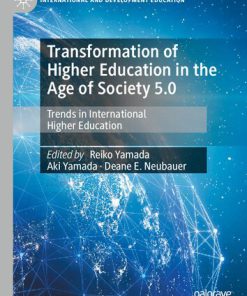Education and Society An Introduction to Key Issues in the Sociology of Education 1st Edition by Thurston Domina, Benjamin Gibbs, Lisa Nunn, Andrew Penner 0520295587 9781071807231
$50.00 Original price was: $50.00.$25.00Current price is: $25.00.
Education and Society An Introduction to Key Issues in the Sociology of Education 1st Edition by Thurston Domina, Benjamin Gibbs, Lisa Nunn, Andrew Penner – Ebook PDF Instant Download/Delivery:0520295587, 9781071807231
Full dowload Education and Society An Introduction to Key Issues in the Sociology of Education 1st Edition after payment

Product details:
ISBN 10: 0520295587
ISBN 13: 9781071807231
Author: Thurston Domina, Benjamin G. Gibbs, Lisa Nunn, Andrew Penner
Drawing on current scholarship, Education and Society takes students on a journey through the many roles that education plays in contemporary societies. Addressing students’ own experience of education before expanding to larger sociological conversations, Education and Society helps readers understand and engage with such topics as peer groups, gender and identity, social class, the racialization of achievement, the treatment of immigrant children, special education, school choice, accountability, discipline, global perspectives, and schooling as a social institution. The book prompts students to evaluate how schools organize our society and how society organizes our schools. Moving from students to schooling to social forces, Education and Society provides a lively and engaging introduction to theory and research and will serve as a cornerstone for courses such as sociology of education, foundations of education, critical issues in education, and school and society.
Education and Society An Introduction to Key Issues in the Sociology of Education 1st Table of contents:
PART 1 Theoretical Orientations in the Sociology of Education
CHAPTER 1 The Growth of Schooling in Global Perspective
Having grown up in and around schools, we all have a considerable store of firsthand knowledge about education. We likely also have strong ideas about the various ways in which schools interact with the societies in which they are located. For example, many of us behave in a way that’s consistent with human capital theory—studying because we believe that the knowledge and skills we accumulate in school will make us more employable, more productive, and better-paid members of the labor force.
What we already know and believe about education and society is a valuable resource to draw upon as…
CHAPTER 2 A Contextual Understanding of Schools’ Role in the Stratification System: Are Schools a Compensatory, Neutral, or Exacerbatory Institution?
One claim that often accompanies efforts to expand formal schooling is the claim that education is an antidote to social inequality. Horace Mann, the nineteenth-century American educator who argued for schools to be freely available to all youth (known as the common schools movement), famously called school “the great equalizer.” Mann’s idea was consistent with the human capital hypothesis. If schools confer valuable skills that students can convert into higher pay in the workplace, then making those skills more widely available should level the playing field, thereby helping everybody, regardless of family background, have a fair shot at social and…
PART 2 Student Experiences in Education
CHAPTER 3 Gender Inequality in Education: Outcomes and Experiences
The evidence that Doug Downey and his colleagues have assembled suggests that schools help compensate for socioeconomic inequalities. But as is often the case in social science, this conclusion comes with many important qualifications: this evidence seems to hold for socioeconomic inequality, in American elementary schools, in the early elementary grades, in regard to the sorts of basic academic skills that standardized tests measure. It is, in other words, just the beginning of a long conversation about education and inequality in the contemporary world.
The chapters in this section continue that conversation.
In this chapter, Catherine Riegle-Crumb, a sociologist and…
CHAPTER 4 Hidden in Plain Sight: Rethinking Race in Education
Race, like gender, clearly influences students’ educational experiences in a myriad of ways, both big and little. In schools, as Downey notes in chapter 2, racial inequalities appear to behave differently than socioeconomic inequalities, and there is some evidence to suggest that schools may exacerbate racial inequalities in education. This finding may not be all that surprising in the context of the United States, where racial inequality—in the form of slavery—is sometimes referred to as the nation’s “original sin,” and where pronounced racial inequalities in wealth, social status, and power persist.
It also shouldn’t be surprising, therefore, that…
CHAPTER 5 Immigrant Children and Children of Immigrants in American Schools: Shifting Demographics
School is one of the first sustained points of contacts between immigrant children, as well as between the children of immigrants and the societies into which they’ve immigrated. As a result, school has long played an important role in the immigrant incorporation process, providing immigrant children and the children of immigrants with the opportunity to learn English as well as to learn about American culture and society. In fact, part of the reason Horace Mann’s nineteenth-century arguments for the construction of “common schools” were so successful was because Mann’s supporters saw these schools as a tool to help “Americanize” newcomers…
CASE STUDY 1 Sexualities in Education
We often think of schools as places where kids learn to read and write, and we often conceptualize their consequences in economic terms. But it’s clear that they are more than that. In chapter 3, Riegle-Crumb provided examples of how schools help shape students’ conceptions of what it means to be a boy or a girl. In chapter 4, Eschmann and Payne told us about how schools help create race and perpetuate racial hierarchies.
University of Oregon sociologist C.J. Pascoe and Northwestern sociologist Tony Silva point out that schools are also profoundly sexual institutions. Intentionally or not, schools often reinforce…
CHAPTER 6 Social Class and Student-Teacher Interactions
Indiana University sociologist Jessica Calarco continues our discussion of the informal ways schools mirror and reinforce the categories that exist in society at large. Calarco has spent years observing informal interactions between students and teachers and studying how these interactions reinforce socioeconomic inequalities.
Calarco introduces the concept of cultural capital. Much like human capital, which we first discussed in chapter 1, cultural capital consists of skills that people employ to advance their interests in the larger society. But while the skills we usually associate with human capital are typically part of schools’ explicit curriculum, the skills we associate with cultural…
CHAPTER 7 First-Generation College Students
The previous two chapters provided rich examples of processes that often lead to the reproduction of social inequality. Because affluent students are at ease in the classroom, they often feel comfortable advocating for themselves and customizing their educational experiences in a way that poor students do not—as Jessica Calarco demonstrates in chapter 6. The peer dynamics that William Carbonaro documents in chapter 8 may compound these advantages, since hanging out with affluent peers may further advantage students. In both cases, these informal processes increase advantaged students’ odds of succeeding in school and enjoying the rewards associated with school success,…
CHAPTER 8 Peer Sorting, Peer Influence, and Student Outcomes
Take a second to remember an experience at school that helped define who you are today. For some of us, the first moment that comes to mind might be the moment when a tough idea final started to make sense, or the moment we discovered a fact or idea that sparked our curiosity. But for many of us, that moment probably has nothing at all to do with a teacher, or a classroom, or a textbook. Instead, it probably happened in the lunchroom or the hallway or the playground, and it probably involved our peers.
Sociologists of education are fascinated…
CASE STUDY 2 The “Asian F” and the Racialization of Achievement
The bulk of the research in the sociology of inequality focuses on the consequences of inequality for relatively disadvantaged groups. As you saw in preceding chapters, women’s experiences in mathematics and science, the structural challenges facing African American children, and the biases and low expectations that teachers bring to their interactions with students from relatively poor families are all topics of particular resonance for sociologists. This emphasis on the experience of the socially disadvantaged makes sense. It reflects a shared belief that understanding the costs of inequality and the processes that produce those costs is an important step toward making…
PART 3 Schools and Other Educational Organizations
CHAPTER 9 Creating the Canon: The Meaning and Effects of Textbooks and Curricula
Each of the chapters in part 2 of Education and Society focus on student educational experiences. By describing the ways in which gender, race, immigration status, class, family educational backgrounds, and peer groups shape both the educational and the social aspects of schooling, these chapters are designed to give you a better sense of how education interacts with social inequality. This line of inquiry is important, and it is central to the sociology of education. But if we focus our attention exclusively on students, it’s easy to forget that the structures in which they learn, interact, and grow are, themselves,…
CHAPTER 10 Sorting Students for Learning: Eight Questions about Secondary-School Tracking
Contemporary schools are, in many ways, bureaucratic organizations. They are formal structures in which power is distributed hierarchically (for example, principals have power over teachers, who in turn have power over students) and people have specialized organizational roles (for example, English teachers teach English while math teachers teach math). They keep detailed written records. And, above all else, they prize rationality.
Academic tracking is an excellent example of the rationalization of instruction in contemporary schools. As University of Pittsburgh education professor Sean Kelly argues, educators sort students for instruction because they think this is an efficient way to match instruction…
CHAPTER 11 Special Education and Social Inequality
In chapter 4, we encountered the idea of social construction when Robert Eschmann and Charles Payne discussed race and racism in education. Race isn’t the only important social construct that operates in contemporary schools. Sociologist Jacob Hibel of the University of California, Davis, discusses a construct that schools explicitly help create: disability.
American educational policy requires that students receive educational opportunities that are appropriate to their needs, and we suspect that in most cases educators identify students for special education with the very best of intentions. But when they do so, they construct an arbitrary line between the “typically developing”…
CHAPTER 12 A Sociology of School Discipline
In chapters 6 and 8, we discussed the subtle and not-so-subtle ways that schools socialize students to behavioral norms. If you’ve ever served a school detention or sat in the principal’s office while your parents received a phone call about your behavior at school, you’ve experienced one of the most direct forms of school-based socialization.
Schools discipline students, in part, to maintain order within the building and keep students safe. But sociologists Richard Arum, Christine Baker-Smith, and Jessica Lipschultz argue that by setting rules and punishing students who break those rules, schools teach students how to follow rules and familiarize…
People also search for Education and Society An Introduction to Key Issues in the Sociology of Education 1st :
key functions of education
education and social issues
education and its impact on society
education as a social problem
Tags:
Thurston Domina,Benjamin Gibbs,Lisa Nunn,Andrew Penner,Education and Society,Key Issues
You may also like…
Politics & Philosophy
Society in Focus: An Introduction to Sociology, Ninth Edition William E. Thompson
Education Studies & Teaching - School Education & Teaching
Exploring Education An Introduction to the Foundations of Education 5th Edition Alan R. Sadovnik
Uncategorized
Uncategorized
Education Studies & Teaching - Higher & Further Education
Computers - Artificial Intelligence (AI)
Education Studies & Teaching - Higher & Further Education
Education Studies & Teaching - Education - General & Miscellaneous











